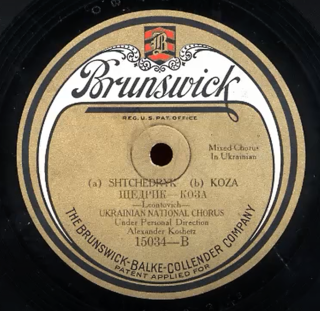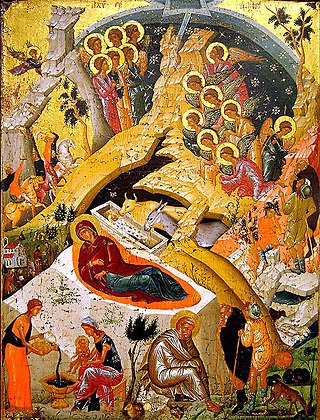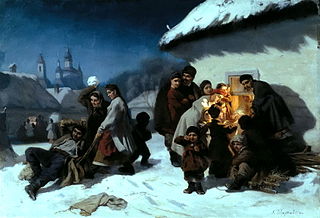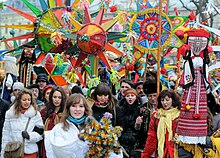
A Christmas carol is a carol (a song or hymn) on the theme of Christmas, traditionally sung at Christmas itself or during the surrounding Christmas and holiday season. The term noel has sometimes been used, especially for carols of French origin. Christmas carols may be regarded as a subset of the broader category of Christmas music.

Christmas Eve is the evening or entire day before Christmas, the festival commemorating the birth of Jesus. Christmas Day is observed around the world, and Christmas Eve is widely observed as a full or partial holiday in anticipation of Christmas Day. Together, both days are considered one of the most culturally significant celebrations in Christendom and Western society.

The kallikantzaros is a malevolent creature in Southeast European and Anatolian folklore. Stories about the kallikantzaros or its equivalents can typically be found in Greece, Bulgaria, Turkey, Serbia, Albania, Bosnia, and Cyprus. Kallikantzaroi are believed to dwell underground but come to the surface during the twelve days of Christmas, from 25 December to 6 January.
Drekavac,, also called drekalo, krekavac, zdrekavac or zrikavac, is a mythical creature in South Slavic mythology. The name is derived from the verb "drečati".

The observance of Christmas around the world varies by country. The day of Christmas, and in some cases the day before and the day after, are recognized by many national governments and cultures worldwide, including in areas where Christianity is a minority religion which are usually found in Africa and Asia. In some non-Christian areas, periods of former colonial rule introduced the celebration ; in others, Christian minorities or foreign cultural influences have led populations to observe the holiday.

Ded Moroz, or Morozko, is a legendary figure similar to Father Christmas, and Santa Claus who has his roots in Slavic mythology. The tradition of Ded Moroz is mostly spread in East Slavic countries and is a significant part of Russian culture. At the beginning of the Soviet era, communist authorities banned Ded Moroz. However, the ban was lifted and he soon became a significant part of Soviet culture. The literal translation of DedMoroz is Grandfather Frost or Old Man Frost, but traditionally the name is translated as Father Frost.

"Shchedryk" is a Ukrainian shchedrivka, or New Year's song, known in English as "The Little Swallow". The song tells a story of a swallow flying into a household to sing of the wealth that will come with the following spring. "Shchedryk" was originally sung on the night of 13 January, New Year's Eve in the Julian Calendar, known in Ukraine as Malanka or Shchedry Vechir. The song is an example of a Ukrainian shchedrivka, whilst the English words of "The Little Swallow" identifies it as a koliadka.

The Yule goat is a Scandinavian and Northern European Yule and Christmas symbol and tradition. Its origin is from Germanic paganism and has existed in many variants during Scandinavian history. Modern representations of the Yule goat are typically made of straw.

Koliadka are traditional songs usually sung in Eastern Slavic, Central European and Eastern European countries during the Christmas holiday season. It is believed that everything sung about will come true.
![<i>The Night Before Christmas</i> (1913 film) 1913 [[Russian Empire]] film](https://upload.wikimedia.org/wikipedia/commons/5/5d/The_Night_Before_Christmas_%281913_film%29%2C_still_01.jpg)
The Night Before Christmas is a 1913 silent film made in the Russian Empire by Ladislas Starevich, based on the 1832 tale of the same name by Nikolai Gogol. Unlike most of Starevich's films, it is mainly live-action.

A colindă is a traditional Christmas carol in Romania and the Republic of Moldova.

The badnjak, also called veseljak, is a tree branch or entire tree that is central to Serbian Christmas celebrations. It is placed on a fire on Christmas Eve and its branches are later brought home by worshipers. The tree from which the badnjak is cut, preferably a young, straight and undamaged oak, is ceremonially felled early on the morning of Christmas Eve. The felling, preparation, bringing in, and laying on the fire, are surrounded by elaborate rituals, with many regional variations. The burning of the log is accompanied by prayers that the coming year brings food, happiness, love, luck, and riches. The log burns on throughout Christmas Day, when the first visitor strikes it with a poker or a branch to make sparks fly, while wishing that the family's happiness and prosperity be as abundant as the sparks. As most Serbs today live in towns and cities, the badnjak is often symbolically represented by a cluster of oak twigs with brown leaves attached, with which the home is decorated on Christmas Eve.

Malanka is a Ukrainian folk holiday celebrated on 31 December, which is New Year's Eve in accordance with the Gregorian calendar, formerly it was celebrated on 13 January corresponding to 31 December in the Julian calendar. The festivities were historically centred around house-to-house visiting by groups of young men, costumed as characters from a folk tale of pre-Christian origin, as well as special food and drink. The context of the rituals has changed, but some elements continue to the present.

In Ukraine, Christmas celebrations traditionally start on Christmas Eve, and last until January 6, the date of the celebration of the baptism of Jesus, known in Ukraine as Vodokhreshche or Yordan, according to the Gregorian calendar and Revised Julian calendar by the Orthodox Church of Ukraine (OCU), the Catholic Church in Ukraine and Ukrainian Protestants.
This article describes Serbian folk astronomy.

Serbian Christmas traditions are customs and practices of the Serbs associated with Christmas and a period encompassing it, between the third Sunday before Christmas Day and Epiphany. Serbian Christmas is celebrated on January 7th. There are many, complex traditions connected with this period. They vary from place to place, and in many areas have been updated or watered down to suit modern living. The Serbian name for Christmas is Božić, which is the diminutive form of the word bog ("god"), and can be translated as "young god". Christmas is celebrated for three consecutive days, starting with Christmas Day, which the Serbs call the first day of Christmas. On these days, one is to greet another person by saying "Christ is Born," which should be responded to with "Truly He is Born," or in Serbian: "Hristos se rodi" – "Vaistinu se rodi".

"Bóg się rodzi" is a Polish Christmas carol, with lyrics written by Franciszek Karpiński in 1792. Its stately melody is traditionally known to be a coronation polonaise for Polish Kings dating back as far as during the reign of Stefan Batory in the 16th century. The carol is regarded by some as the National Christmas hymn of Poland, and, for a short time, it was also considered a national anthem, for instance by poet Jan Lechoń. It has also been called "one of the most beloved Polish Christmas carols".

Koliada or koleda is the traditional Slavic name for the period from Christmas to Epiphany or, more generally, for Slavic Christmas-related rituals, some dating to pre-Christian times. It represents a festival or holiday, celebrated at the end of December to honor the sun during the Northern-hemisphere winter solstice. It also involves groups of singers who visit houses to sing carols.
The Serbs have many traditions. The Slava is an exclusive custom of the Serbs, each family has one patron saint that they venerate on their feast day. The Serbian Orthodox Church uses the traditional Julian Calendar, as per which Christmas Day falls currently on January 7 of the Gregorian Calendar, thus the Serbs celebrate Christmas on January 7, shared with the Orthodox churches of Jerusalem, Russia, Georgia, Ukraine and the Greek Old Calendarists.

Koliada or Koleda is a Slavic pseudo-deity, a personification of the newborn winter Sun and symbol of the New Year's cycle. The figure of Koliada is connected with the solar cycle, passing through the four seasons and from one substantial condition into another.












![<i>The Night Before Christmas</i> (1913 film) 1913 [[Russian Empire]] film](https://upload.wikimedia.org/wikipedia/commons/5/5d/The_Night_Before_Christmas_%281913_film%29%2C_still_01.jpg)







